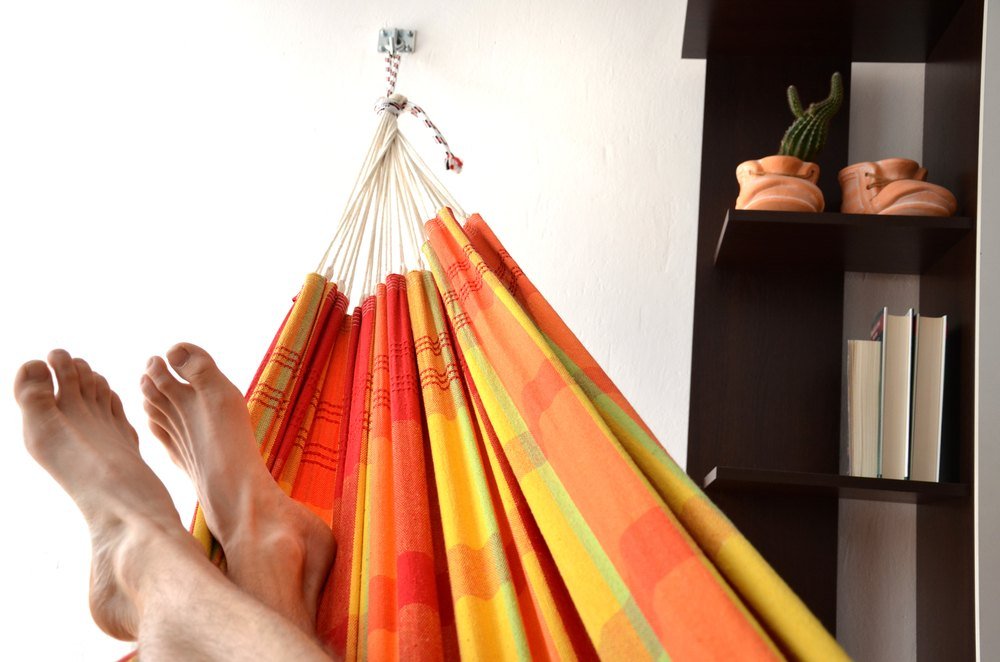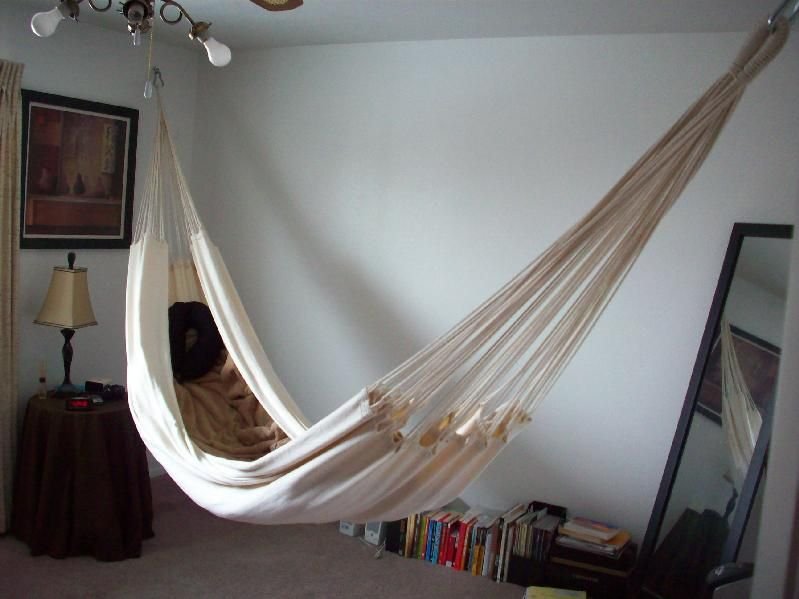Many of us would like to have a hammock inside our houses to enjoy the pleasant rocking and freshness of taking a nap. However, it’s not everyone who knows how to hang a hammock indoors. If you are experiencing some difficulty hanging your hammock inside your house, then we have some great news for you!
In this guide, we will walk you through some simple ways to hang your hammock indoors. More than that, you will also learn some safety measures to adopt when hanging a hammock indoors.
But before we dive in, how about checking if you have the necessary equipment in your DIY toolkit?

Contents
Simple pieces of equipment for hanging your hammock Indoors
The following tools enable you to hang the hammocks anywhere around your home.
Measuring Tape
You need the tape to measure the length between both walls and the distance of your hammock to the ground. The hammock’s end should be about 5.75 ft (or 67″) from the ground when the hammock is not carrying any weight.
Still carrying no weight, the distance from the hammock seat to the ground is supposed to be about 1 – 2.5 feet or 12″ – 30″. This helps you enjoy the mid-air feeling of relaxing in your hammock.

Driller
You need the driller to screw perfect holes into the wall and ceiling. The hole should be a bit smaller than the screws you want to put into the wall so that it can be tight after screwing.
Eyebolts and hooks
The S hooks eye bolts are used as secure anchor points on ceiling joists and wall beams. These hammock hooks indoor can hold the hammocks between posts.
Cords and Rope
The cords and rope help to suspend the hammock indoors. It is best for your indoor suspension hammock to stick with chains if you are not experienced with safe methods of tying knots.
Ropes and straps can help you adjust the hammock at any given time. These ropes and cords are attached to connection points that are already available.
Chains
Chains are safe suspension materials that make it easy to adjust the S-hooks. You may have to slide your hammock hook indoors up or down the chain to adjust the tensile force on the hammock.
On top of that, metal chains are extremely strong. Thus, you won’t have to worry about wearing down the weight in the long run.
There you go, the necessary DIY toolkit for hanging a hammock. Follow along to learn how to hang your hammock indoors?
Three Tips to Anchor Your Hammock Chair Indoors
Whether you want a corner to nap, read, or play video games, etc., you can never go wrong when you hang your hammock using any of these methods. They include:
- Hanging the hammock between two walls
- Hanging or suspending the hammock from a ceiling
- Hanging the hammock without damaging the walls
1. How to Hang a Hammock using Two walls
This is one of the most common ways of hanging hammocks indoors. Here, you simply have to tie the hammock to two walls. The walls may be at a right-angled or parallel position to each other.
As a first-timer, a right-angle wall will be your surest bet. We say this because parallel walls can pose some difficulties as you have to ensure that the hammock length and the distance between the walls are properly matched.
Not to worry, here is a step by step guide on how to anchor the hammock using two walls:
- Measure the distance between the walls
- Find the right place on the wall to hang your hammock
- Drill the holes in the selected areas.
- Screw in a top-quality iron eye bolt on both sides of the wall.
- Link the chain (a small length) to the iron bolt on both sides.
- Connect the hammock tip to the S hooks and link it to the chain on both sides.
Points to consider:
It is very important to ensure that the walls where you place the anchor are at least 14cm thick. You can easily check the wall thickness by the sound produced when you hit it with your knuckles.
If it produces little or no sound, then it is most likely a thick wall. However, if the sound is hollow, it may not support the hammock. And, It is not advisable to anchor a hammock to a hollow wall.

Another way to check the wall’s thickness is to use the stud finder. The stud finder helps you ascertain the thickness of the wall and the best place to hang your hammock indoors.
As a caution, ensure that the walls are at least 10-11 inches apart to achieve maximum results. You can also check out the best hammocks with mosquito nets.
2. How to Hang a Hammock from the Ceiling
The second way to anchor the hammock is through the ceiling. This gives you much more flexibility than the wall option. However, you should check if the place where you want to anchor the hammock has a false ceiling.
The false plaster ceilings are usually made of hardwood, and some are thick enough to make it look like a solid ceiling, but they aren’t. You may try to drill a hole in the ceiling anyway to check if it is false or not. Normally, a plaster ceiling would not be thicker than 3-4 cm.
With that in mind, let’s move on to the steps to hang hammock from ceiling safely.
- Locate the ceiling joists. The ceiling joist, otherwise known as ceiling beams, are pieces of hardwood used for holding heavy frameworks in the building. You will usually find them in the ceiling or walls.
- Find the center of the wood joist and drill a hole to the right using small bits.
- Mark the position of the second anchor point, and drill a hole in it. This second anchor point should be on the left side of the beam center not to overload the beam. Also, the two anchor points should be 30 – 50cm apart, depending on the hammock length and how high/low you want it to sag above the ground level.
- After this, insert eye-bolts into the holes. At this point, you want to make sure your hole is deep enough to hold the hammock firmly.
- Hang your hammock to the ceiling wood joist. You can do this by connecting a rope or chain to the ends of the hammock.
- Finally, use a knot to fasten the rope to the eye-bolt. There may be a need to adjust the suspension until the hammock length and angle can support your weight.
One of the perks of hanging your hammock from the ceiling is that it requires minimum space. You can also anchor the equipment anywhere you want and choose between installing the regular hammock sleeping pads or the hammock chairs instead.

Hanging a hammock from the ceiling is pretty safe too. Nonetheless, many people still fear that their walls and ceilings could get damaged when they suspend their hammocks from those structures.
So, here is another piece of heart balm – a tested way to hang your hammock indoors without having to damage your walls.
How to go about it? Let’s dive right in!
3. How to Hang Hammocks Indoors Without Damaging Walls: Hammock Stand
A stand is one of the simplest methods of hanging a hammock, either outdoors or indoors. You can choose to move the hammock and the stand to any part of the house you want. You may not have to carry the hammock stand with you every time you are outdoor, but they may add some beauty to your indoor space.

Now that we’ve seen some simple ways to hang hammocks indoors, let’s look at some safety precautions to observe when hanging your hammock.
Safety Precautions to Consider in Hanging a Hammock Outdoors
Overlooking some steps while hanging your hammocks indoors may lead to accidents and structural damage. Hence, you must ensure that you take caution while anchoring your hammock indoors.
The safety tips for practicing while hanging a hammock indoors are:
- Under no circumstances must you anchor the hammock on drywall alone. The fact that you found a stud or wood joist doesn’t mean they are strong enough to withstand your weight. Also, weak studs tend to move vertically along the wall. Therefore, it would help run the stud finder multiple times over the area you plan to drill to avoid structural damage.
- The tools and materials used at every stage of the hammock installation must be of premium quality. You don’t want to use a soft rope, brittle hook, or a hammock made of inferior material.
- Ensure that your measurements are precise. These include finding the precise center of the wood joist, the length between the two anchor points, and the distance between the hammock and the ground level.
- Lastly, no matter how careful you were while installing the hammock, ensure that you conduct an integrity test before sitting on it. To test your hammock, put weights, books, etc. Tweak the suspension angle and the hammock length until you find a comfortable and safe position. And when you decide to lay in your hammock, make sure you get into it slowly.
It is normal for people with bigger body size to experience difficulty finding a decent hammock to support their weight. So, here are some perfect hammock suggestions for big guys that you can try out to help you relax more comfortably.

FAQs
Can I hang a hammock in my room?
You can hang a hammock in your room and other parts of the house like your verandah or even the living room. One factor you should consider before making this choice is the availability of space. Once there is enough space to accommodate a hammock, you’re good to go!
How can I hang a hammock without screws?
You can hang a hammock without screws when you use a hammock stand. Some hammocks come with stands and can be more expensive than others. However, installing such hammocks requires less work as screws and drillers are not needed. You can also try out a DIY wood hammock stand:
How many hammocks can I have in my home?
The number of hammocks you want in your home is totally up to you to decide. You can have hammocks in different parts of the house, as earlier mentioned. As long as you have enough space for your hammock, you’re good to go!
Final Thoughts
Now, we have seen how to hang a hammock indoors. The safety precautions above should also be observed to ensure that you safely hang your hammock indoors. Don’t hesitate to contact a professional to help you get the work done in cases of uncertainty.

